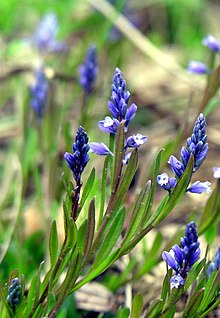Polygala amarella
| Dwarf milkwort | |
|---|---|

| |
| Scientific classification | |
| Kingdom: | Plantae |
| Clade: | Tracheophytes |
| Clade: | Angiosperms |
| Clade: | Eudicots |
| Clade: | Rosids |
| Order: | Fabales |
| Family: | Polygalaceae |
| Genus: | Polygala |
| Species: | P. amarella
|
| Binomial name | |
| Polygala amarella | |
Polygala amarella (or P. amara), commonly known as dwarf milkwort or Kentish milkwort,[1] is a plant of the family Polygalaceae. A European native, it grows on chalky grass land and limestone mountain pastures.
Description
[edit]The plant typically grows up to 20 cm tall and has small, blue-purple flowers that bloom from May to August. The leaves are alternate, narrow, and smooth-edged, and the stems are slender and wiry.
Identification
[edit]This species is very similar to chalk milkwort but can easily be separated from it by the rosette leaves being basal in dwarf milkwort, but slightly raised on the stem in chalk milkwort. Also, dwarf milkwort has a bitter taste (not so in chalk milkwort). In dwarf milkwort the inner sepals are longer than the petals.[2]
Uses
[edit]Polygala amarella has traditionally been used in herbal medicine.[3]
In media
[edit]In 2009 it featured on a first class Royal Mail stamp in the series "Endangered Plants".[4]
References
[edit]- ^ "Magpie Bottom citation" (PDF). Sites of Special Scientific Interest. Natural England. Retrieved 18 February 2018.
- ^ Stace, C.A. (2019). New Flora of the British Isles (4th ed.). Suffolk: C&M Floristics. ISBN 978-1-5272-2630-2.
- ^ Blaschek, W.; Hänsel, R.; Keller, K.; Reichling, J.; Rimpler, H.; Schneider, G., eds. (1998). "Hagers Handbuch der Pharmazeutischen Praxis". doi:10.1007/978-3-642-58928-7.
{{cite journal}}: Cite journal requires|journal=(help) - ^ Plants (Action for Species) Archived 2011-06-08 at the Wayback Machine
